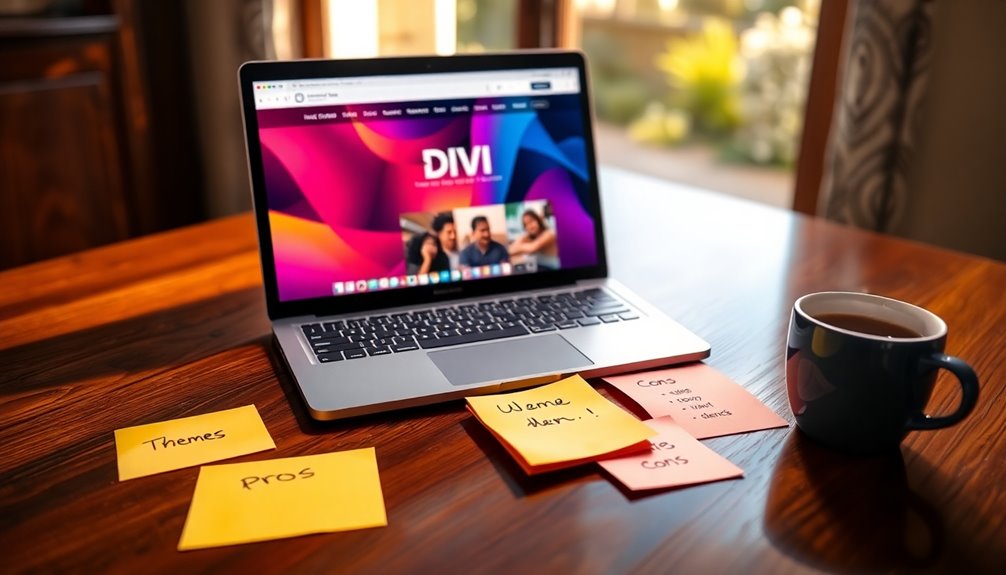When you explore Divi, you'll notice it's a versatile WordPress theme loved for its drag-and-drop builder and extensive template library. Many users praise its flexibility, but some find the interface overwhelming and clunky, especially new users. Performance can suffer due to its heavy file size, and the reliance on shortcodes raises concerns during theme changes. Despite these issues, the pricing is competitive, especially for long-term users. Ultimately, Divi appeals to both casual creators and professionals, balancing usability with power. Keep going to uncover deeper insights and personal experiences from those who've used Divi extensively.
Overview of Divi Theme
Divi is a versatile WordPress theme created by Elegant Themes, designed to make website building accessible for everyone, regardless of their skill level. With its intuitive drag-and-drop visual builder, you can easily create stunning websites without any coding knowledge. This theme integrates smoothly with the WordPress Customizer, providing a WYSIWYG editing experience that allows you to see changes in real time.
Divi stands out with its extensive library of over 214 pre-made templates that are fully responsive and customizable, catering to various design preferences and site types. Whether you're building a blog, portfolio, or e-commerce site, Divi's flexibility makes it easy to use for any project. Additionally, it's important to ensure your hosting provider offers performance optimization features to maintain the speed and efficiency of your Divi site. A reliable hosting provider with robust security measures can also enhance the overall performance and safety of your website.
However, it's worth noting that Divi does have a larger file size of 9.7MB, which might raise some performance concerns compared to lighter themes. Additionally, it's important to consider that many bloggers prefer lightweight themes like Astra for faster loading times.
The pricing model is subscription-based, offering options of $89 per year or a one-time payment of $249 for lifetime access, including all products from Elegant Themes.
User Experience Insights
Many users find that maneuvering the interface can be a bit overwhelming at first, as it requires several clicks just to access basic features. This can detract from your overall editing experience.
While Divi offers a variety of layout options, many users describe the process of editing blog posts as cumbersome. The extensive options can hinder your writing flow, making it feel less user-friendly than alternatives like Elementor or Thrive Architect. Additionally, the importance of regular updates can significantly enhance security, which is sometimes overlooked by users relying on Divi. Implementing strong passwords can further protect your site from unauthorized access.
Additionally, the reliance on shortcodes can complicate maintenance if you decide to disable Divi, leaving behind clutter that could confuse anyone managing your WordPress site in the future. Many report a steep learning curve, particularly if you're not a developer. This steepness can be frustrating and may make you feel stuck when trying to achieve your desired design outcomes.
Even though Divi incorporates drag-and-drop functionality, users often find it limited and clunky. Moving through numerous icons to find essential tools can make the editing process feel tedious. Furthermore, the lack of regular updates can leave your site vulnerable to known vulnerabilities that could compromise its security. Regularly changing passwords also helps in strengthening account security against potential threats.
Performance and Technical Limitations

When using Divi, you might notice some performance concerns due to its heavy file size and complex codebase, which can slow down your site. Regular daily backups are crucial for maintaining the integrity of your content and ensuring that any changes made are securely saved. Additionally, the reliance on WordPress shortcodes can complicate your editing process, especially if you decide to switch themes later. These technical limitations can impact your overall experience, making site management more challenging than it needs to be. Implementing caching plugins can significantly improve site speed and reduce page load times, enhancing your website's performance. To further optimize your site, consider utilizing SEO plugins that can aid in managing your content and improving your search engine rankings.
Performance Concerns
While Divi boasts impressive layout-building features, its performance concerns can't be overlooked. The Divi builder plugin's heavy codebase can notably impact site load times, which may frustrate you and your visitors.
Here are some key performance issues to evaluate:
- File Size: At 9.7MB, Divi's file size can slow down your site compared to lighter themes like GeneratePress.
- Visual Builder Clunkiness: Many users find the visual builder cumbersome, leading to a steep learning curve for those unfamiliar with WordPress.
- User Experience: Performance issues often arise from the complex interface, which can overwhelm average users and hinder effective site management.
- Shortcode Reliance: The use of shortcodes can complicate editing and leave behind remnants if you decide to disable the theme, complicating maintenance.
These performance concerns may deter you from fully embracing Divi, especially if you're looking for a user-friendly experience.
While it offers powerful tools, the trade-offs in speed and usability are essential to weigh before diving in.
Shortcode Limitations
Although Divi's shortcode system offers some convenience for building layouts, it comes with significant limitations that can hinder your site's performance and flexibility.
One major concern is that the reliance on shortcodes creates a rigid structure, complicating your editing process. When you disable Divi, leftover shortcodes can clutter your site, making maintenance and theme switching a nightmare.
Moreover, Divi offers a heavy codebase, which may lead to slower site load times—something you definitely want to avoid. Users often find that these shortcode limitations restrict design flexibility, making it difficult to implement custom designs without extensive workarounds or custom code snippets. This can be frustrating if you envision a unique look for your site.
Additionally, the complexity introduced by shortcodes can overwhelm new users, contributing to a steeper learning curve when maneuvering the Divi interface.
While Divi has its merits, if you're looking for a builder that allows for more freedom in design and easier maintenance, you might want to explore other options that utilize direct HTML and CSS instead.
Comparison With Competitors
In the landscape of WordPress page builders, Divi stands out for its lifetime membership option at $249, appealing to long-term users seeking cost-effective solutions.
This offers a significant advantage over competitors like Elementor Pro, which requires an annual commitment of $49 without a lifetime plan.
When comparing Divi with other popular builders, you may want to evaluate the following points:
- Pricing: Divi's lifetime plan can save you money in the long run compared to Thrive Themes' Thrive Architect at $228/year.
- Flexibility: While Divi excels in layout options and pre-made designs, Elementor is often praised for its intuitive interface, making it easier for non-developers.
- Usability: Many users find Divi's learning curve steep, especially when compared to the user-friendly experiences offered by Thrive Architect and Elementor.
- Shortcode Limitations: Divi's reliance on WordPress shortcodes may create rigid structures that complicate theme switching and site maintenance.
Additionally, investing in backup solutions can protect your website content, ensuring that your work remains safe from data loss incidents.
In your Divi Theme Review, weigh these factors carefully to see if using Divi aligns with your website needs.
Pros and Cons Analysis

Evaluating Divi's strengths and weaknesses reveals a mixed bag of features that can considerably impact your website-building experience.
On the positive side, the Divi Theme Builder combines a powerful page builder with extensive layout customization options, making it a versatile choice for users looking to create unique designs. The library of pre-made layouts is a valuable resource, allowing you to jumpstart your projects.
However, many users encounter a steep learning curve that can overwhelm newcomers, leading to a frustrating editing experience. The interface, while feature-rich, often feels confusing and clunky.
Additionally, Divi's reliance on shortcodes poses a significant drawback. If you ever decide to switch themes, remnants of these shortcodes can linger, complicating maintenance and clean-up.
Usability is another concern; while the drag-and-drop functionality is intended to simplify your design process, excessive clicks are often required to achieve desired results, which hampers efficiency.
Pricing and Value Evaluation
When considering Divi's pricing, you'll notice it offers two main plans that cater to different needs.
The lifetime plan stands out as a smart choice for anyone looking to save in the long run, especially if you plan to use Divi for more than 34 months.
With a robust set of features and design flexibility, you'll find that Divi delivers great value compared to its competitors.
Membership Cost Comparison
Divi offers two attractive pricing options that cater to different user needs: an annual membership at $89 or a one-time lifetime plan for $249.
When considering a membership cost comparison, it's crucial to evaluate what you get with each option:
- Annual Membership: At $89/year, you gain access to all Elegant Themes products, making it a great choice for short-term users.
- Lifetime License: For $249, you can purchase Divi outright, saving money if you plan to use it for over 34 months.
- Elementor Pro: Priced at $49/year, it doesn't offer a lifetime option, which might limit long-term savings.
- Thrive Architect: Part of the Thrive Suite, it costs $228/year, catering to a different audience focused on conversion optimization.
While Divi's pricing is competitive, some users express mixed value perception due to performance issues related to its file size of 9.7MB.
User ratings reflect this with quality at 4.3, but value and support are both high at 4.8.
Ultimately, deciding between Divi and alternatives like Elementor Pro or Thrive Architect hinges on your specific needs and expected usage.
Lifetime Plan Advantage
For many users, the appeal of the lifetime plan lies in its cost-effectiveness and long-term value. Priced at $249, this plan is a smart choice if you plan to use the Divi theme for over 34 months, as it saves you money compared to the annual plan.
With the lifetime membership, you get ongoing updates and support indefinitely, ensuring you're always using the latest features without incurring additional costs.
Another major perk is the unlimited website usage under a single license, making it a cost-effective option for developers and agencies managing multiple client sites. You won't have to worry about licensing fees piling up as you expand your portfolio.
Plus, the membership includes access to all Elegant Themes products, giving you additional resources and tools beyond just the Divi theme.
When you compare this to competitors like Elementor Pro, which lacks a lifetime option, Divi's lifetime plan stands out. It offers long-term users a unique advantage, providing stability in pricing and features while allowing you to invest confidently in your projects.
Value for Features
Releasing value for features, Divi presents a competitive pricing structure that appeals to both casual users and professionals.
With options like a yearly plan at $89 and a one-time lifetime membership for $249, Divi makes it easy to see why users consider it a good investment. If you plan on using the Divi Builder for over 34 months, the lifetime plan offers significant long-term savings.
Here's what adds to the value for features:
- Extensive Template Library: With over 214 pre-made templates and modules, building websites becomes streamlined and cost-effective.
- High User Ratings: Users rate Divi 4.3 for quality, 4.8 for value, and 4.8 for support, indicating satisfaction with its offerings.
- Versatile Themes: It's a popular theme that caters to a variety of design needs without hidden costs.
- Learning Curve: While some users mention challenges with the interface, the overall features provided justify the investment.
In my experience, the combination of affordability and rich features makes Divi a strong contender in the landscape of website-building tools.
Ideal Users for Divi

Many creative users will find Divi to be a game-changer for building visually stunning websites from scratch. With its intuitive Visual Editor, you can easily customize your site using extensive customization options and a library of pre-made layouts.
Whether you're a small business owner looking to establish a professional online presence without coding knowledge or a developer wanting to leverage powerful layout-building capabilities, Divi caters to your needs.
If you manage multiple client websites, such as in an agency setting, you'll appreciate Divi's cost-effective pricing model that allows unlimited website usage under a single license. This feature not only saves you money but also streamlines your workflow.
Moreover, if you're someone recovering from hair loss or aiming to enhance scalp health, you might find that Divi's focus on user results resonates with your goals.
Positive feedback from users achieving noticeable improvements showcases the platform's commitment to effective outcomes.
Conclusion
So, if you're looking for a magical solution to all your web design woes, Divi might just be your fairy godmother—if your idea of magic involves a few quirks and a sprinkle of patience. Sure, it's got its charms, but don't expect it to wave a wand and make you a design guru overnight. Remember, every tool has its flaws, so you might want to keep your expectations in check while you're busy conjuring up that perfect site!



